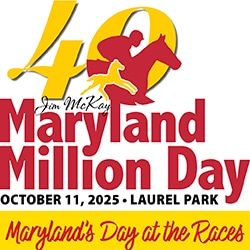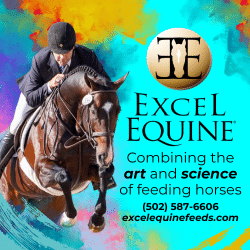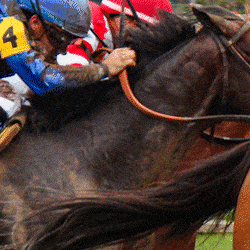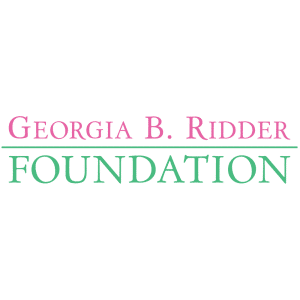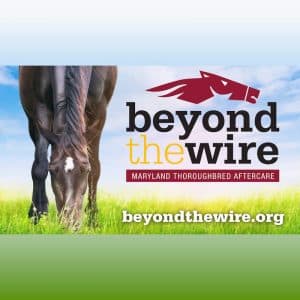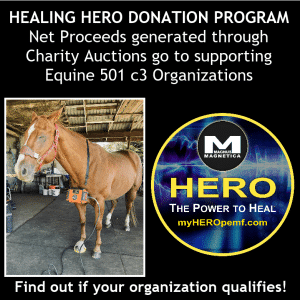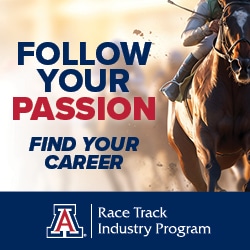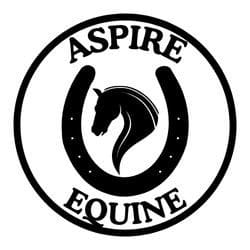How to evaluate product quality and claims, plus supplement categories that might benefit your horse

Courtesy Retired Racehorse Project
Have you flipped through a supplement catalog recently or browsed through your feed store’s supplement aisle? It can seem like there’s a supplement for everything that ails (or will someday ail) your horse. Reading the labels and the opinions on online forums supporting supplement use, you might feel like your OTTB needs all the supplements.
The truth is, your horse might benefit from certain nutritional supplements, but it’s easy to get overwhelmed in this crowded marketplace that offers conflicting claims, comparison charts and rider testimonials. It’s also possible to spend a lot of money on things your horse doesn’t really need.
With the help of independent equine nutrition consultant Clair Thunes, PhD, who operates Summit Equine Nutrition LLC, in Gilbert, Arizona, we’ll share how you can evaluate a product’s quality and claims and look at types of supplements that might benefit OTTBs.
What Is a Supplement?
A supplement is a product that provides a nutrient your horse might not otherwise consume in large enough amounts to meet his needs. Equine industry studies show more than half of all U.S. horse owners offer their horses supplements. Those supplements typically fall into two categories:
1. Nutritional or feed supplements, designed to meet a horse’s needs when nutrients are missing from the diet.
2. Health supplements, intended to support maintenance of normal biological structure and function.
Under federal law, manufacturers can’t claim their products prevent, treat or cure diseases. However, companies don’t have to prove to the Food and Drug Administration (FDA) that their dietary supplements are safe before marketing them to the public.
The FDA does allow supplement manufacturers to make what are known as “structure function” claims, says Thunes. These claims are typically related to general well-being but can also be related to nutrient deficiency disease. A structure function claim is one that describes a nutrient’s role in the structure or function of the horse’s body. For example, “calcium builds strong bones.”
Know What You’re Buying
So, if the FDA doesn’t approve supplements, how do you know if they work or if certain brands offer high-quality products? The American Association of Equine Practitioners recommends using the acronym “ACCLAIM” when evaluating joint supplements, but you can apply the concept to any supplement you might give your horse.
A: A company you recognize
C: Clinical experience (a company that supports research and publishes results in peer-reviewed journals)
C: Contents (ingredients) clearly identified on the label
L: Label claims shouldn’t be unrealistic (avoid words like “cure” or “prevent”)
A: Administration recommendations are clearly stated on the label
I: Identification of a lot number and expiration date
M: Manufacturer information includes the company’s name and contact info
Another indication of quality comes from the National Animal Supplement Council (NASC). This voluntary trade organization offers its “NASC Seal of Quality” to member companies that meet its strict manufacturing and labeling standards and submit their products to independent audits.
First, a Balanced Diet
On the most basic level, your OTTB needs vitamins and trace minerals to supplement any deficiencies in his forage or meet his individual needs. You can identify those deficiencies by having your hay’s nutritional content analyzed. Then you can work with a nutritionist or your veterinarian to balance the diet. Blood tests, often indicated when a horse seems lethargic, has a dull coat or is unthrifty, can also help identify dietary deficiencies.
For a simple approach to supplementing your OTTB, Thunes recommends offering a concentrate feed following the manufacturer’s instructions.
“These feeds have been carefully formulated to ensure that all the horse’s nutrient needs are met based on their level of work, breeding status and age,” Thunes says. “When fed correctly, they do a very good job of ensuring a balanced diet. Problems occur, however, when owners do not feed per the manufacturer’s recommendations, and diets often end up with deficiencies when this happens.”
In addition to important vitamins and trace minerals, these feeds offer other necessary nutrients, such as fat and protein (including amino acids that support muscle and topline health).
If you and your nutritionist or veterinarian find your horse is still deficient, you can work with them to find specific vitamin and mineral supplements to add to the diet.
Joint Support
Your OTTB is an athlete and, like any athlete, his training and competing likely put stress on his joints and bones. Joint issues are common problems for any competition or aging horse, making joint supplements one of the most popular categories of nutraceuticals (generally, supplements, along with products derived from foods but believed to provide additional health benefits beyond those of the basic essential nutrients for horses), Thunes says.
Joint supplement ingredients vary greatly and generally target inflammation. Some you might see include glucosamine (hydrochloride, sulfate or N-acetyl-D-glucosamine), chondroitin sulfate, methylsulfonylmethane (MSM) and/or resveratrol. Other products can include hyaluronic acid, cetylated fatty acids, omega-3 fatty acids, Perna mussel, collagen/gelatin, avocado-soybean unsaponifiables (ASU), vitamin C, herbs (yucca, Devil’s claw, Boswellia) and other proprietary or patented ingredients.
“I look for products that have research published in peer-reviewed journals,” Thunes says, noting specifically research that supports results related to certain ASU- or resveratrol-containing supplements. “These research-backed products may be more expensive; however, they do at least give some guarantee that they may work. But, as an example, not all glucosamine is the same, and so it is hard to compare across products.”
Digestion
Research shows that racing Thoroughbreds have higher instances of gastric ulcers than other domesticated horses, with some studies indicating that up to 93% of racing Thoroughbreds suffer from equine gastric ulcer syndrome (EGUS). Stress and high-starch diets — common on the track — make horses more susceptible to EGUS. Clinical signs of EGUS include but aren’t limited to an inability to gain weight, grumpiness, anxiety, lethargy, reluctance to move forward under saddle, “cinchiness” and colic. Less understood are colonic or “hindgut” ulcers (the hindgut being the gastrointestinal tract beyond the small intestine) — and there’s some disagreement about whether colonic ulcers are a real issue for horses, says Thunes. Those who theorize hindgut ulcers are a problem relate them to reduced nutrient absorption, diarrhea and behavioral issues.
The first step, if you suspect your OTTB has ulcers, is to contact your veterinarian. The only sure way to diagnose EGUS is via a small scope that allows the veterinarian to examine the stomach. After making a diagnosis, your veterinarian will help formulate a treatment and management plan.
As you’re treating your horse’s ulcers medically, and after your horse has improved, your veterinarian might suggest feeding digestive health nutritional supplements. Ingredients might include digestive enzymes, antacids, licorice, glutamine, aloe vera, seabuckthorn berry, prebiotics (such as fiber-rich psyllium), probiotics (such as certain yeast strains and beneficial bacteria) and various other compounds.
“You have to understand what the ingredients each do and what you are trying to mitigate,” Thunes says. “Some are specific to the stomach and others the hindgut. Some have been shown to help build robust tissue, others are buffers, and others aim to influence the hindgut bacterial population.”
Weight Gain
Many Thoroughbreds are notoriously hard keepers. That is, they have fast metabolisms and struggle to gain weight. When dealing with an underweight OTTB, the first step is to address any digestive health issues already discussed. Ask your veterinarian or equine nutritionist about appropriate weight-building supplements that can help add concentrated calories to the horse’s ration. These usually provide calories in the form of fat from sources such as flaxseed, rice bran or vegetable oils.
“Feeding oil is very popular,” Thunes says. “However, it is important to understand that most oil provides only calories. It’s possible, therefore, if feeding a lot of oil, to create a diet that is calorie-rich but lacking in other key nutrients such that, overall, the horse does not thrive. It’s my preference to start by feeding (formulated concentrate) high-fat feeds that tend to have a more complete nutritional profile.”
Hoof Health
Thoroughbreds aren’t known for their great feet. That’s partly due to the soft stall and track environment racehorses live in and partly genetics, Thunes says. While you can’t completely change a hoof using supplements, you can support what nature gave your horse. With that in mind, you might want to consider adding a supplement that supports hoof health.
Hoof health stands on a good basic nutritional foundation. Even the best-footed horse will lose hoof quality if his basic vitamin, mineral, protein, fat and calorie needs aren’t met. That’s where a ration balancer or concentrate that meets your OTTB’s basic dietary need for things like copper, zinc and amino acids comes into play.
Beyond the basics, research supports using biotin for improving hoof wall quality and condition. “Biotin is needed by a lipoprotein whose job it is to cement together cells in the hoof, helping them to adhere together,” Thunes says. “Therefore, it’s particularly useful for horses with shelly or flaky feet.”
When giving hoof supplements, don’t expect results right away, because it can take months to see any noticeable new hoof wall growth, she says.
Calming
Racing is a high-adrenaline, high-energy sport, so the fact that some OTTBs might require calming support — especially during their transition — isn’t surprising. Calming supplement ingredients vary greatly product-to-product. Some support the nervous system and must be given days or weeks for you to see improvement, while others offer nearly immediate sedative effects. Ingredients can include B vitamins (thiamine), magnesium, L-tryptophan and herbs such as valerian and chamomile.
Another calming supplement ingredient is alpha-casozepine, a milk-derived protein that has soothing effects in a variety of species. Researchers on a 2012 University of Pennsylvania study investigated its influence on learning in ponies and found it might benefit those in potentially stressful management situations.
Take-Home Message
Supplementation can help you ensure your OTTB’s diet meets his nutritional needs. Health supplements might additionally help support his other health needs. However, supplements do not have to pass FDA scrutiny before being marketed to horse owners. When in doubt, talk to your equine nutritionist or vet before starting your horse on any new supplements.
Show Regulations
Just because a supplement includes natural ingredients doesn’t mean it’s show-legal. In fact, most governing bodies have long lists of forbidden substances that include common supplement ingredients. Consult your association — whether it’s USEF, the FEI or another organization — to learn what ingredients are allowed.
This article was originally published in the Fall 2019 issue of Off-Track Thoroughbred Magazine, the only publication dedicated to the Thoroughbred ex-racehorse in second careers. Want four information-packed issues a year delivered to your door or your favorite digital device? Subscribe now!

